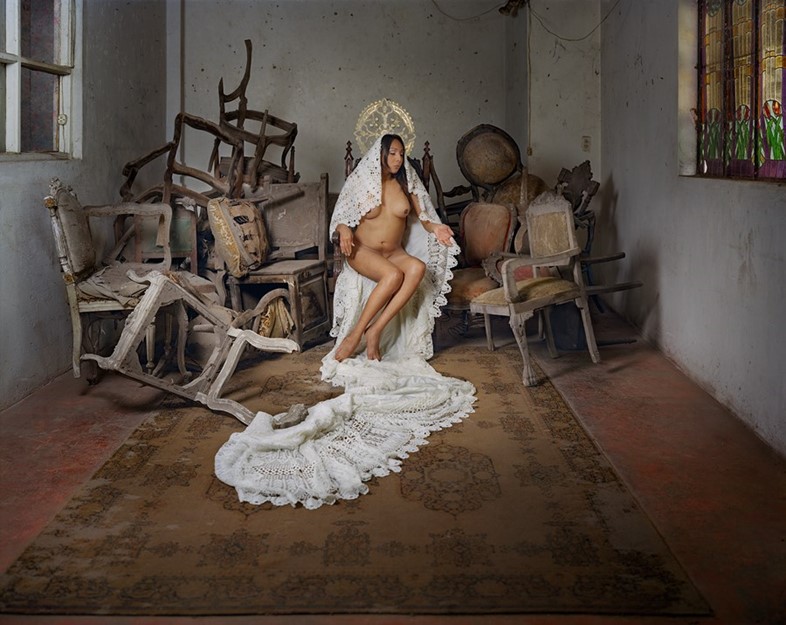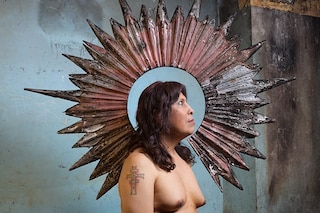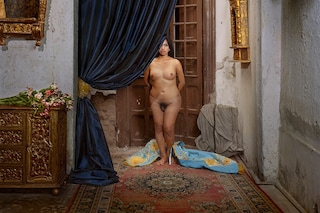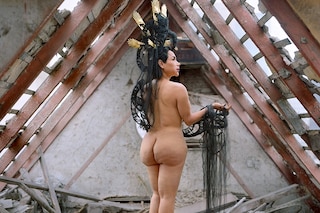Juan Jose Barboza-Gubo and Andrew Mroczek photograph trans women reclaiming their freedom in a country where religion deeply oppresses them
In Peru, religion is intrinsic to cultural identity. Catholicism, the country’s biggest religion, is so dominant as a power structure, that it is deeply intertwined with politics, pouring money from the church into swaying political action. So what does it mean for minority groups when religion has the power to dictate reality?
For Peruvian trans women, it means severe oppression. Not only are they denied access to basic healthcare and employment, but they are marginalised from their own culture and religion – even though a large percentage of Peruvian trans women are devoutly Catholic.
Understanding the critical role inclusion plays in one’s identity are photographers Juan Jose Barboza-Gubo and Andrew Mroczek, who have spent four years turning trans women into religious icons for their photo series Virgenes de La Puerta. Using traditional religious iconography, Virgenes de La Puerta aims to re-embed 17 trans women into their own culture. Loaded with symbolism, the series is meticulously planned down to every detail, including handcrafted crowns from the artisan who makes them for the Catholic church, hand-sewed silk veils, and Peruvian relics. Through Barboza-Gubo and Mroczek's lens, the women are powerfully illuminated in their natural courage and strength.
Not only is Virgenes de La Puerta important because it immortalises these women as permanent figures of history that can’t be oppressed, but it has stirred debate in Peru. After the series’ release, a Peruvian congressman condemned it as ‘blasphemous’ and is now trying to impose a law where anyone who offends the church could face imprisonment.
At a politically tense moment in Peru, we speak with Barboza-Gubo and Mroczek about why it is important to celebrate Peru's trans community, and why art should forever be free to comment on religion.
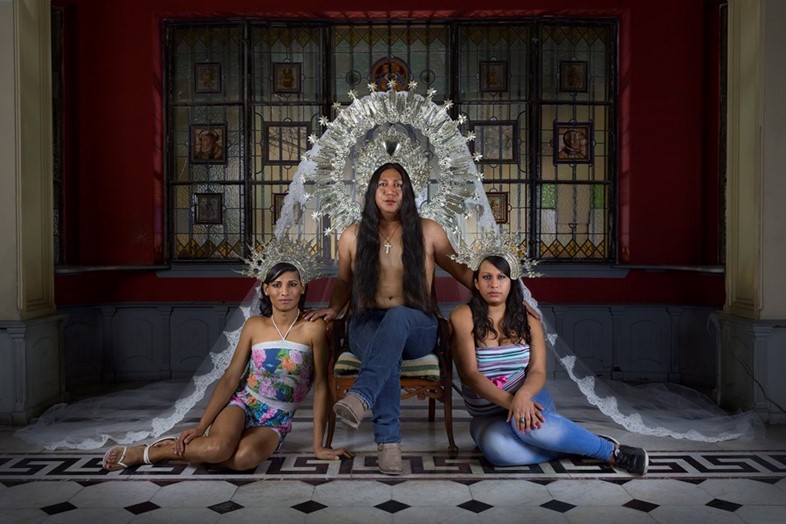
How did Virgenes de la Puerta begin?
Andrew Mroczek: Juan was born in Peru and spent much of his life there. When he was around seven years old, he witnessed the beating of a transwoman on the street. It was a difficult situation for him to witness not only because it was the worst act of violence he had seen, but what left a bigger impression on him was that no one helped the woman at all. I think from there, it's always been in the back of his mind to do something to help the community.
Is that the main reason why you decided to do the project?
Andrew Mroczek: The goal was to give these women a platform, after being silenced for so long. When we say they are considered the lowest form of life in Peru, that is the absolute truth. There is so much marginalisation, so much oppression, so little resources that these women have access to. From the stories that we have heard from all of the interviews that we have done, I am quite surprised that most of them were able to survive some of the situations that were put in.
So much of the project is about re-immersing and re-embedding them into the culture that they love; their culture. They want to feel represented. For most trans women, they are not allowed to participate in most church and cultural functions. So for them to be able to see themselves in their own culture was incredibly important. The majority, if not all the women, are very Catholic. So it's very difficult for them to not be accepted by their own church.
“So much of the project is about re-immersing and re-embedding them into the culture that they love; their culture. They want to feel represented” – Andrew Mroczek
What is everyday life like for trans women in Peru?
Andrew Mroczek: In the US and in Peru, you have access to things like education. After you finish your studies, you go out and find a job. That's something that really instils a lot of pride in most people. But for Peruvian trans women, most of the time they are not accepted into colleges. For those who are, it‘s rare for them to find employment. So the daily life of a transwoman in Peru really is a life of poverty for most of them. That's where sex work comes in. One of the most startling revelations was listening to these women talk about how the average Peruvian person would not give them any opportunities but would be willing to take from their bodies through sex work. The clients that they have are predominantly self-prescribed, heterosexual men who were the same people who oppress them. That has to be one of the most degrading scenarios that you could possibly be put in: to need the men who oppress you in order to survive.
What other struggles do trans women in Peru face?
Andrew Mroczek: Healthcare is incredibly important for them. Gabby, for example, once needed to go the hospital to be treated for something that was routine, like a cold. When she entered the hospital and they realised she was a trans woman, she was taken to the opposite end of the building to an isolated wing, away from the general population. From there, they touched her as if she was an animal and forced her to take blood to do an HIV test. She didn’t even end up being treated for what she went in for. The forced removal of someone's blood without knowing what it is for is so wrong. It's these type of stories that became painfully repetitious for all of the women, whether it had to do with health care, identification, name changes, police protection, police brutality.
It's amazing that these women would allow themselves to become bigger targets. That was another issue that Juan and I grappled with. How much of a representational project do we want to make knowing that they are already targets. Obviously at the same time this could provide a platform for them. But we have seen other instances where this type of platform has backfired on them. So that was a whole other ball game in terms of gaining their trust.
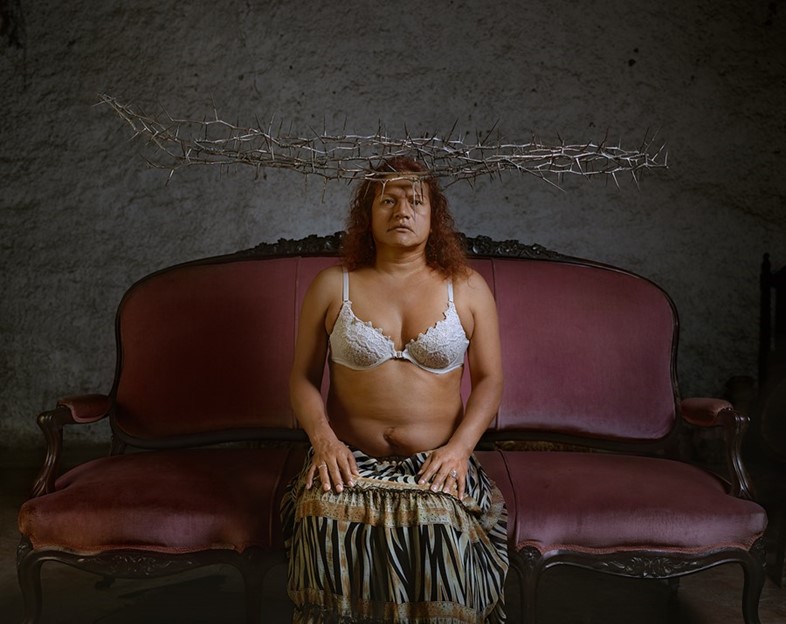
Why do you use religious Peruvian iconography in the series?
Juan Jose Barboza-Gubo: Peru is so devoutly Catholic. Most of South America will consider it the hub of Catholicism for the continent. There is so much visual language and code that exists within the associated iconography, whether it's the crowns, the capes, the fabrics. We also reference folklore because Peruvians are incredibly proud people and for them, to be apart of their culture is one of the most important feelings. It's such an integral part of who they are as people that for transwomen to be rejected is a difficult feeling.
Andrew Mroczek: Our use of that iconography is about inclusion, but it's also about elevation. The crowns, the capes and the gowns talk about social status. We worked with local artisans to make all of the iconography because we want that authenticity. Juan is Peruvian, I am American, and we grappled with ensuring we weren't stepping on ideas of cultural appropriation. We wanted the women, and the people of Peru to make as much of the project with us as they could.
“It's amazing that these women would allow themselves to become bigger targets... Obviously at the same time this could provide a platform for them” – Andrew Mroczek
What has been the outcome of Virgenes de la Puerta so far?
Juan Jose Barboza-Gubo: There has been an increase in the pride of the women in the project. They now set higher goals for themselves. As the gay and trans communities in Peru are getting stronger, and coming together more to fight for equal rights, they are just setting their goals higher. It’s less about 'I just want to be considered normal' and more about 'we can be better than normal/average'. And they deserve it.
I heard that the show had quite severe backlash from the Peruvian government, one congressman calling the show blasphemous…
Juan Jose Barboza-Gubo: Catholicism in Peru is in strong ties with the government. They work together they decide laws. It’s known that the Peruvian cardinal gets involved in politics a lot. He even puts money from the church to the government to change the laws the way that he wants. He has his own radio channel, and he convinces people to do certain things. It's just really complicated. But, what happened was that after the show, a congressman proposed a new law that says if you offend or disrespect any religion, specifically the Catholic church, in any way, you will go to jail for a minimum two years, maximum four. So right now, there is a huge drama in Peru defining what that law means, what freedom of speech means. This was all based on the series.
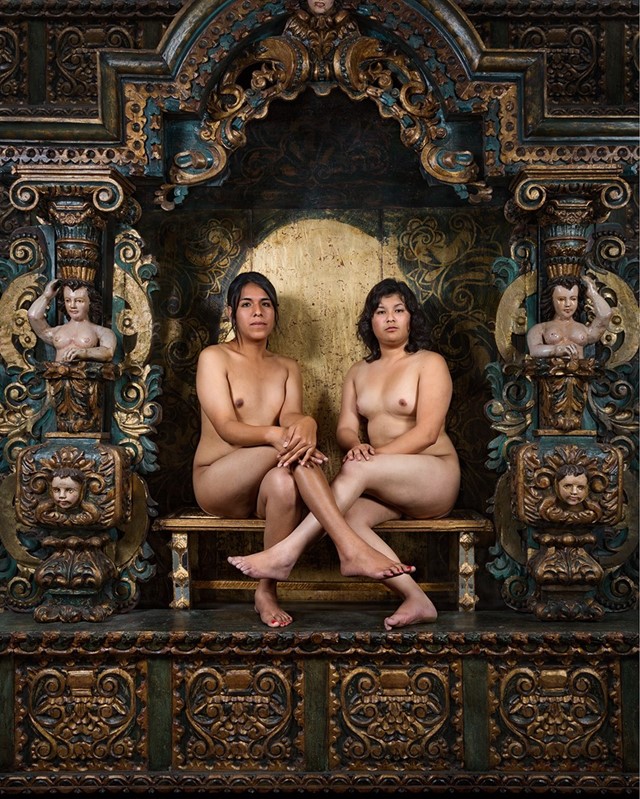
It is crazy that the series could evoke such a strong reaction...
Andrew Mroczek: I know! And when the congressman was asked if he had seen the exhibition, and he said no! But he still claims it as blasphemous? But the larger issue is that he paints the Catholic church and himself as a victim. And he uses the series to justify that.
In Peru, the corruption within the church makes the church a villain, not a victim. So, now the bully is claiming to be the victim and it's absolutely disgusting that he would even propose that, especially knowing that the Catholic church in Peru has committed heinous crimes against humanity. The church is responsible for destroying hundreds of Inca temples in a way to force people to believe in Catholicism, and he is asking for the everyday average Peruvian to defend them. And again, these women, for the most part, most of them are Catholic. So to call the exhibition blasphemous when we are using the iconography in the same way that the church uses it, to tell a story, isn't the problem for this congressman or the church, its transwomen. But he just cannot say it, he won't say it.
Why is it important that art has the freedom to comment on religion?
Andrew Mroczek: When you consider any major movement within humanity, visual language is of utmost importance. When talking about issues of humanity, how else can we really be critical, how else can we really investigate something that isn't commonly done before? The impact of visual imagery really resonates with people. If you think about how the church has commissioned painters and paintings in order to spread their message. I think Juan and I are really just continuing that thread. It's critical to utilise this language and to have this freedom of speech, and artistic expression in order to establish a narrative for the subjects we are photographing.
What will be their future?
Andrew Mroczek: They have to succeed and they will succeed – everything points to it. They are fighters.
You can find out more about Virgenes de la Puerta here
